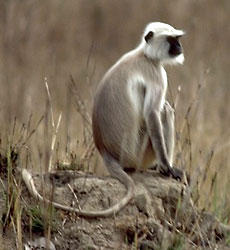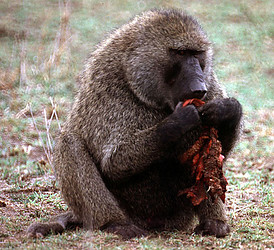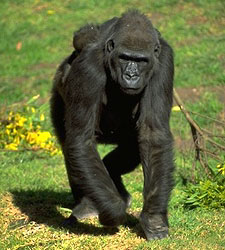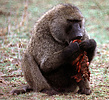Catarrhini
Humans, great apes, gibbons, Old World monkeys



This tree diagram shows the relationships between several groups of organisms.
The root of the current tree connects the organisms featured in this tree to their containing group and the rest of the Tree of Life. The basal branching point in the tree represents the ancestor of the other groups in the tree. This ancestor diversified over time into several descendent subgroups, which are represented as internal nodes and terminal taxa to the right.

You can click on the root to travel down the Tree of Life all the way to the root of all Life, and you can click on the names of descendent subgroups to travel up the Tree of Life all the way to individual species.
For more information on ToL tree formatting, please see Interpreting the Tree or Classification. To learn more about phylogenetic trees, please visit our Phylogenetic Biology pages.
close boxReferences
Andrews, P. 1996. Palaeoecology and hominoid palaeoenvironments. Biological Reviews of the Cambridge Philosophical Society 71:257-300.
Arnason, U., A. Gullberg, A. Janke, and X. F. Xu. 1996. Pattern and timing of evolutionary divergences among hominoids based on analyses of complete mtDNAs. Journal of Molecular Evolution 43:650-661.
Benefit, B. R. 1999. Victoriapithecus: The key to old world monkey and catarrhine origins. Evolutionary Anthropology 7:155-174.
Benefit, B. R. and M. L. McCrossin. 1997. Earliest known Old World monkey skull. Nature 388:368-371.
Caccone, A. and J. R. Powell. 1989. DNA divergence among hominoids. Evolution 43:925-942.
Collard, M. and B. Wood. 2000. How reliable are human phylogenetic hypotheses? Proceedings of the National Academy of Sciences (USA) 97:5003-5006.
Cowlishaw, G. and J. E. Hacker. 1997. Distribution, diversity, and latitude in African primates. American Naturalist 150:505-512.
Gibbs, S., M. Collard, and B. Wood. 2000. Soft-tissue characters in higher primate phylogenetics. Proceedings of the National Academy of Sciences (USA) 97:11130-11132.
Goodman, M., D. A. Tagle, D. H. A. Fitch, W. Bailey, J. Czelusniak, B. F. Koop, P. Benson, and J. L. Slightom. 1990. Primate evolution at the DNA level and a classification of hominoids. Journal of Molecular Evolution 30:260-266.
Harrison, T. 1987. The phylogenetic relationships of the early catarrhine primates: A review of the current evidence. Journal of Human Evolution 16:41-80.
Harrison, T, and Y. M. Gu. 1999. Taxonomy and phylogenetic relationships of early Miocene catarrhines from Sihong, China. Journal of Human Evolution 37:225-277.
Purvis, A. 1995. A composite estimate of primate phylogeny. Philosophical Transactions of the Royal Society of London Series B 348:405-421.
Rae, T. C. 1999. Mosaic evolution in the origin of the hominoidea. Folia Primatologica 70:125-135.
Raaum, R. L., K. N. Sterner, C. M. Noviello, C. Stewart, and T. R. Disotell. 2005. Catarrhine primate divergence dates estimated from complete mitochondrial genomes: concordance with fossil and nuclear DNA evidence. J. Hum. Evol. 48: 237–257.
Ruvolo, M. 1997. Genetic diversity in hominoid primates. Annual Review of Anthropology 26:515-540.
Steiper, M. E., N. M. Young, and T. Y. Sukarna. 2004. Genomic data support the hominoid slowdown and an Early Oligocene estimate for the hominoid-cercopithecoid divergence. Proceedings of the National Academy of Sciences (USA) 101(49):17021-17026.
Stewart, C. B. and T. R. Disotell. 1998. Primate evolution - in and out of Africa. Current Biology 8:R582-R588.
Young, N. M. and L. MacLatchy. 2004. The phylogenetic position of Morotopithecus. Journal of Human Evolution 46(2):163-184.
Title Illustrations

| Scientific Name | Presbytis (Semnopithecus) entellus |
|---|---|
| Location | Khana (India) |
| Comments | Hanuman langur |
| Creator | Robert Thomas and Margaret Orr |
| Specimen Condition | Live Specimen |
| Source Collection | CalPhotos |
| Copyright |
© 2001 California Academy of Sciences

|
| Scientific Name | Gorilla gorilla gorilla |
|---|---|
| Location | San Francisco Zoo, San Francisco, California (US) |
| Comments | Lowland gorilla |
| Creator | Photograph by Gerald and Buff Corsi |
| Specimen Condition | Live Specimen |
| Source Collection | CalPhotos |
| Copyright |
© 2001 California Academy of Sciences

|
About This Page
Page copyright © 1999
All Rights Reserved.
Citing this page:
Tree of Life Web Project. 1999. Catarrhini. Humans, great apes, gibbons, Old World monkeys. Version 01 January 1999 (temporary). http://tolweb.org/Catarrhini/16293/1999.01.01 in The Tree of Life Web Project, http://tolweb.org/












 Go to quick links
Go to quick search
Go to navigation for this section of the ToL site
Go to detailed links for the ToL site
Go to quick links
Go to quick search
Go to navigation for this section of the ToL site
Go to detailed links for the ToL site